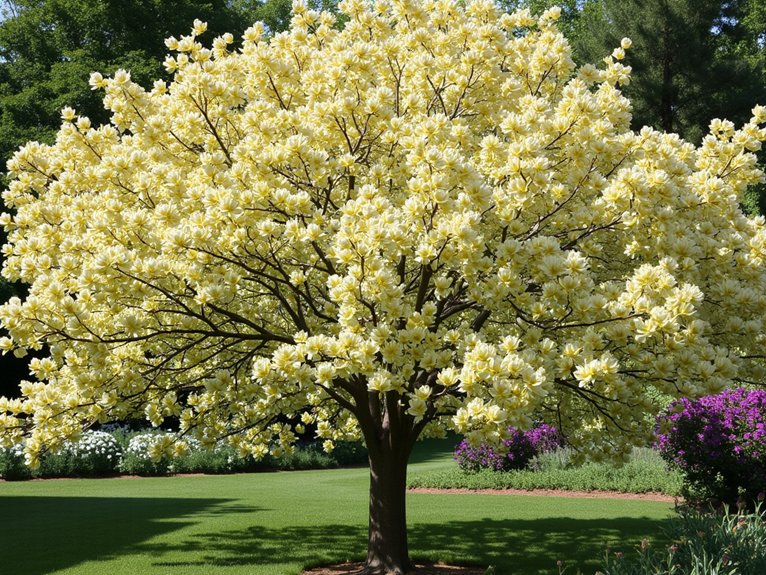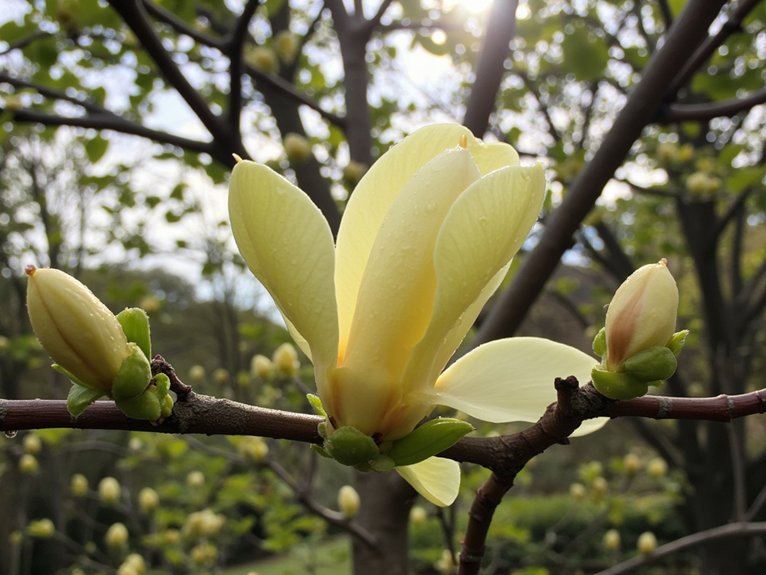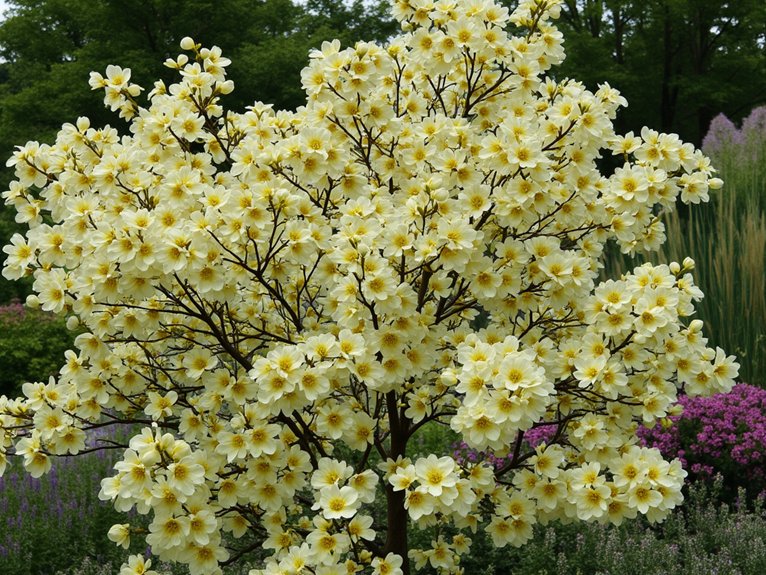Yellow magnolias represent a transformative addition to modern garden design, offering unique golden blooms that command attention. “These trees bring instant sophistication through their unusual coloring and classic form,” notes botanist Dr. Sarah Chen. Their flowers range from pale butter-yellow to deep golden hues, emerging dramatically against dark foliage each spring. Understanding the specific varieties, planting requirements, and maintenance needs will determine success with these exceptional specimens.
Contents
Why Yellow Magnolias Stand Out in Landscape Design

Yellow magnolias create striking focal points in landscape design through their unique combination of size and color. Their vibrant golden blooms, ranging from pale butter to rich canary yellow, break from traditional white magnolia varieties and add unexpected color symbolism representing optimism and energy in the garden space.
These statement trees provide multi-season interest, starting with early spring flowers on bare branches, followed by lush summer foliage reaching heights of 20-40 feet. Their architectural branching patterns create visual appeal even in winter dormancy. Whether planted as standalone specimens or incorporated into mixed borders, yellow magnolias command attention while maintaining elegant sophistication in any landscape design.
Popular Yellow Magnolia Varieties for Your Garden
Gardeners seeking to add striking color to their landscapes can choose from several magnificent yellow magnolia varieties, each offering unique characteristics and growing requirements.
Popular yellow magnolia hybrids like ‘Butterflies’ produce vibrant canary-yellow blooms with a delightful lemon scent, growing 25-30 feet tall. The ‘Elizabeth’ variety displays pale yellow, fragrant flower varieties reaching heights of 40 feet. For smaller spaces, ‘Judy Zuk’ offers an upright growth pattern of 20-30 feet with elegant golden blooms.
‘Golden Pond’ and ‘Hot Flash’ provide late-season options, featuring rich golden flowers and excellent frost resistance.
Choosing the Right Yellow Magnolia for Your Climate

When selecting a yellow magnolia variety, careful consideration of regional climate zones guarantees successful growth and abundant seasonal blooms. For coldest regions (zones 4-5), varieties like ‘Elizabeth’ and ‘Solar Flair’ offer excellent hardiness, while warmer zones (7-9) can support more delicate options like ‘Butterflies’.
Climate considerations extend beyond just temperature. Late-blooming varieties perform better in areas prone to spring frosts, while early bloomers thrive in regions with mild winters. Urban gardeners should note that varieties like ‘Judy Zuk’ and ‘Yellow Bird’ demonstrate particular resilience to city conditions.
Essential Care Tips for Yellow Magnolia Success
Successful cultivation of these stunning trees depends on establishing proper growing conditions from the moment of planting. Yellow magnolias thrive in well-draining, slightly acidic soil with a pH between 5.5 and 6.5. Proper watering techniques involve maintaining consistent moisture without waterlogging the roots.
“Deep, infrequent watering encourages strong root development,” explains botanist Dr. Sarah Chen. “Apply 2-3 inches of organic mulch around the base, keeping it 6 inches away from the trunk.” The mulch helps retain moisture while regulating soil temperature, essential for healthy growth in both summer and winter.
Pairing Yellow Magnolias With Companion Plants

Complementing yellow magnolias with thoughtfully selected companion plants creates visual depth and extends seasonal interest in the garden. “The bright yellow blooms pair beautifully with early spring bulbs and understory plantings that bloom at different times,” notes landscape designer Maria Foster.
For striking color contrast, combine magnolias with:
- Purple hellebores beneath the canopy
- Blue woodland phlox along borders
- White bleeding hearts for shade areas
- Deep purple alliums for late spring
- Pink azaleas for concurrent blooming
Consider mature plant sizes when companion planting to guarantee all species have adequate space to thrive without competing for resources.
Urban Gardening With Yellow Magnolias
Despite their grand appearance in traditional landscapes, yellow magnolias can thrive beautifully in urban settings with proper planning and variety selection. “Many newer cultivars like ‘Butterflies’ and ‘Hot Flash’ have more compact growth habits ideally suited for city lots,” explains urban horticulturist Dr. Sarah Chen.
For tight spaces, consider vertical gardening techniques. Magnolias like ‘Judy Zuk,’ with its narrow 6-8′ spread, can be trained against walls. Even container gardening is possible with dwarf varieties, though pots must be at least 30″ deep to accommodate root systems. Urban gardens benefit from late-blooming varieties that avoid spring frost damage common in city heat islands.
